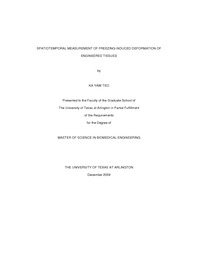| dc.contributor.author | Teo, Ka Yaw | en_US |
| dc.date.accessioned | 2010-03-03T23:30:38Z | |
| dc.date.available | 2010-03-03T23:30:38Z | |
| dc.date.issued | 2010-03-03T23:30:38Z | |
| dc.date.submitted | January 2009 | en_US |
| dc.identifier.other | DISS-10474 | en_US |
| dc.identifier.uri | http://hdl.handle.net/10106/2044 | |
| dc.description.abstract | In order to cryopreserve functional engineered tissues (ETs), the microstructure of extracellular matrix (ECM) as well as the cellular viability should be maintained given that the functionality of ETs is closely related to the ECM microstructure. Since the post-thaw ECM microstructure is determined by the deformation of ETs during cryopreservation, the freezing-induced deformation of ETs was measured in the present study with a newly developed quantum dot (QD)-mediated cell image deformetry technique using dermal equivalents as a model system. The dermal equivalents were constructed by seeding QD-labeled fibroblasts in type I collagen matrices. After 24 hour incubation, the ETs were directionally frozen by exposing them to a spatial temperature gradient (from 4 °C to -20 °C over a distance of 6 mm). The ETs were consecutively imaged while being frozen. Consecutive pairs of these images were two-dimensionally cross-correlated to determine the local deformation during freezing. The results showed that freezing induced the deformation of ET, and its magnitude varied with both time and location. The maximum local dilatation was 0.006 s<super>-1</super> and was always observed at the phase change interface. Due to this local expansion, the unfrozen region in front of the freezing interface experienced compression. This expansion-compression pattern was observed throughout the freezing process. In the unfrozen region, the deformation rate gradually decreased away from the freezing interface. After freezing/thawing, the ET experienced an approximately 28% decrease in thickness and 8% loss in weight. These results indicate that freezing-induced deformation caused the transport and extrusion of interstitial fluid. In summary, the results suggest that complex cell-fluid-matrix interactions occur within ETs during freezing, and these interactions determine the post-thaw ECM microstructure and eventual post-thaw tissue functionality. | en_US |
| dc.description.sponsorship | Han, Bumsoo | en_US |
| dc.language.iso | EN | en_US |
| dc.publisher | Biomedical Engineering | en_US |
| dc.title | Spatiotemporal Measurement Of Freezing-induced Deformation Of Engineered Tissues | en_US |
| dc.type | M.S. | en_US |
| dc.contributor.committeeChair | Han, Bumsoo | en_US |
| dc.degree.department | Biomedical Engineering | en_US |
| dc.degree.discipline | Biomedical Engineering | en_US |
| dc.degree.grantor | University of Texas at Arlington | en_US |
| dc.degree.level | masters | en_US |
| dc.degree.name | M.S. | en_US |
| dc.identifier.externalLink | https://www.uta.edu/ra/real/editprofile.php?onlyview=1&pid=245 | |
| dc.identifier.externalLinkDescription | Link to Research Profiles | |

